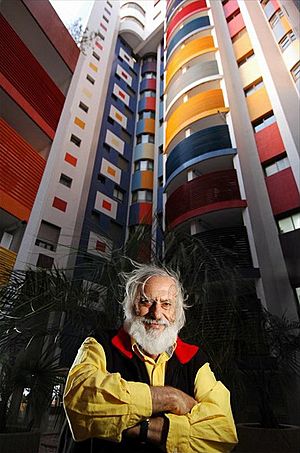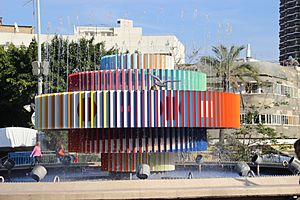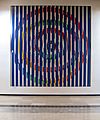Yaacov Agam facts for kids
Quick facts for kids
Yaacov Agam
|
|
|---|---|
| יעקב אגם | |

Yaacov Agam in front of a building he decorated in Tel Baruch, Tel Aviv, Israel
|
|
| Born |
Yaakov Gipstein
11 May 1928 |
| Citizenship | Israeli |
| Education | The Bezalel Academy of Art and Design in Jerusalem, the Kunstgewerbe Schule |
| Occupation | Sculptor and experimental artist |
| Known for | Contributions to optical and kinetic art |
Yaacov Agam, born on May 11, 1928, is a famous Israeli artist. He is known for his unique sculptures and art that moves or changes when you look at it. This type of art is called optical art and kinetic art.
Contents
Yaacov Agam's Early Life and Training
Yaacov Agam was born in a place called Mandate Palestine. His original name was Yaacov Gibstein. His father, Yehoshua Gibstein, was a rabbi, which is a Jewish religious leader.
Agam studied art at the Bezalel Academy of Art and Design in Jerusalem. In 1949, he moved to Zürich, Switzerland, to continue his studies. There, he learned from a teacher named Johannes Itten. He was also inspired by the artist Max Bill.
In 1951, Agam moved to Paris, France, where he still lives today.
Exploring Art and Movement
Agam had his first art show in Paris in 1953. He also showed his work at important art exhibitions in 1954 and 1955.
Agam's art is usually abstract, meaning it doesn't show real-life objects exactly as they are. His art often includes movement, light, and sound. He wants people to interact with his artworks.
Famous Artworks and Public Displays
Many of Agam's artworks are placed in public spaces for everyone to enjoy. Some of his most famous pieces include:
- Double Metamorphosis III (created in 1965)
- Visual Music Orchestration (from 1989)
- A special fountain in the La Défense area of Paris (made in 1975)
- The Fire and Water Fountain in Dizengoff Square in Tel Aviv (finished in 1986)
Agam is also known for a type of print called an "Agamograph." These prints use a special technique to show different images depending on where you stand to look at them. A large example of this is "Complex Vision" (1969), which is 30 feet (about 9 meters) tall. It's on the outside of the Callahan Eye Foundation Hospital in Birmingham, Alabama.
Exhibitions and Recognition
Agam's art has been shown in major museums around the world. He had big shows at the Musée National d'Art Moderne in Paris in 1972 and at the Solomon R. Guggenheim Museum in New York City in 1980. His works are also part of many museum collections, including the Museum of Modern Art.
Two documentary films have been made about his work: Possibilities of Agam (1967) and Agam and... (1980).
In 1996, UNESCO gave him the Jan Amos Comenius Medal. This was for his "Agam Method," which helps teach visual education to young children.
He also designed the trophy for the Eurovision Song Contest 1999, which took place in Jerusalem.
Recent Works and Achievements
In 2009, when he was 81 years old, Agam created a large monument called Peaceful Communication with the World. This artwork was for the World Games 2009 in Kaohsiung, Taiwan. It has nine hexagonal pillars, each 10 meters (about 33 feet) tall. The sides of the pillars are painted with different patterns and colors.
One of Agam's most famous creations is the World's Largest Menorah in New York City. It stands at the corner of Fifth Avenue and 59th Street. This golden steel structure is 32 feet (about 9.7 meters) high and weighs 4,000 pounds (about 1,814 kilograms). The Guinness Book of World Records recognizes it as the "world's largest Hanukkah menorah."
In May 2014, Agam's artwork Faith- Visual Pray was given to Pope Francis. This piece included important symbols from both Jewish and Christian faiths.
Agam's artworks are among the most valuable by any Israeli artist. In 2009, one of his pieces, 4 Themes Contrepoint, sold for $326,500 at an auction.
In 2018, the Yaacov Agam Museum of Art (YAMA) opened in his hometown of Rishon LeZion, Israel. Agam said that it is "the only museum in the world that is dedicated to art in motion."
Images for kids
-
Work by Agam at the Sheba Medical Center, Israel
-
Work by Agam in Green Mountain Falls, Colorado (2022)
See also
 In Spanish: Yaacov Agam para niños
In Spanish: Yaacov Agam para niños
- Visual arts in Israel
- List of public art in Israel








